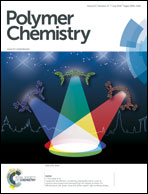Synthesis and properties of hydrophilic–hydrophobic diblock copolymer ionomers based on poly(p-phenylene)s†
Abstract
Diblock copolymer ionomers SP1-P2(m-n) with ion exchange capacity (IEC) of 0.96–2.42 meq g−1 were prepared. The parent diblock copolymers P1-P2(m-n) having various block lengths (m, n) were synthesized via successive catalyst-transfer polymerization of 1,4-dibromo-2,5-di[4-(2,2-dimethylpropoxysulfonyl)phenyl]butoxybenzene (1) and 1,4-dibromo-2,5-hexyloxybenzene (2). The molecular weights were successfully controlled by the feed ratio of the monomer and catalyst, and the molecular weight distribution values were less than 1.32, irrespective of the polymerization degree or polymerization order. Preliminary morphological studies showed that the diblock copolymer ionomers SP1-P2(m-n) had a clear phase separation that could be controlled by the ratios and lengths of the hydrophilic and hydrophobic units. The ionomers showed high proton conductivities with a small humidity dependence, indicating that the clear phase separation formed by the precisely controlled molecular weight and polydispersity index (PDI) of the diblock copolymers enhanced the ionic connectivity and proton conductivity.


 Please wait while we load your content...
Please wait while we load your content...